Wallpaper for the kitchen: the subtleties of choice
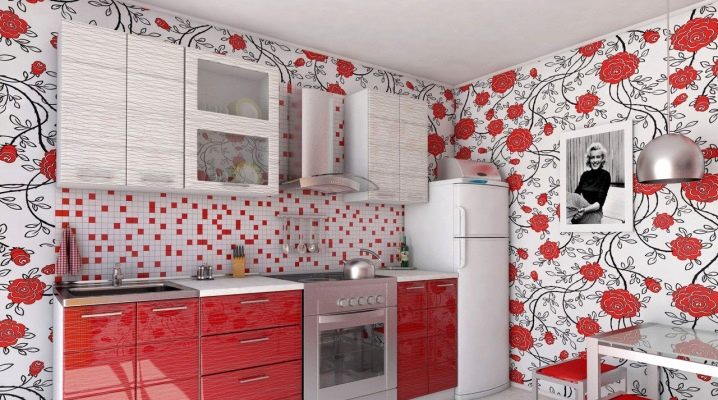
If you are interested in the issue of wallpaper selection, it means that your house needs to be renovated. Someone will invite a designer and professional craftsmen to change the kitchen look. But the designer's opinion is his opinion, even if it is agreed with you. And few people like to let strangers into their "fortress". This means that we will do the repairs on our own. One of the main points in this business is the choice of wallpaper for the kitchen.
The main criteria for choosing
Indeed, the reasons for buying wallpaper for the kitchen can be different. The most common ones are gluing in a new building, planned replacement, complete renovation of the interior, an emergency (neighbors flooded it), putting in order of temporary housing (rented apartment, summer house). The choice of the type of wallpaper depends on the reason for the purchase.
The size of the kitchen also matters. It depends on it how often the wallpaper will be exposed to friction, accidental touches. The choice of type and price characteristics of kitchen wallpaper also depends on this.
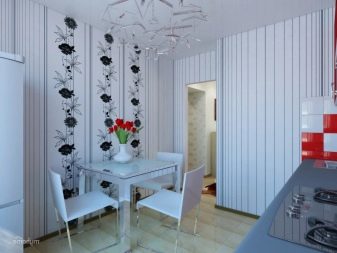
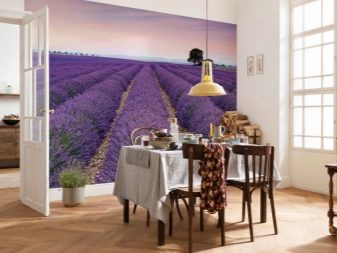
Environmental friendliness of the premises is another important criterion. Unfortunately, not everyone is lucky enough to have a well-built housing. And if the apartment or house has high humidity, then the wallpaper will have to be selected even more carefully so that they do not get wet and do not turn black from the fungus.
The presence of children and animals also has a significant impact on the appearance of wall paintings. If your beloved children are at the age of drawing on the walls and tearing off the wallpaper from them, then this will have to be foreseen.
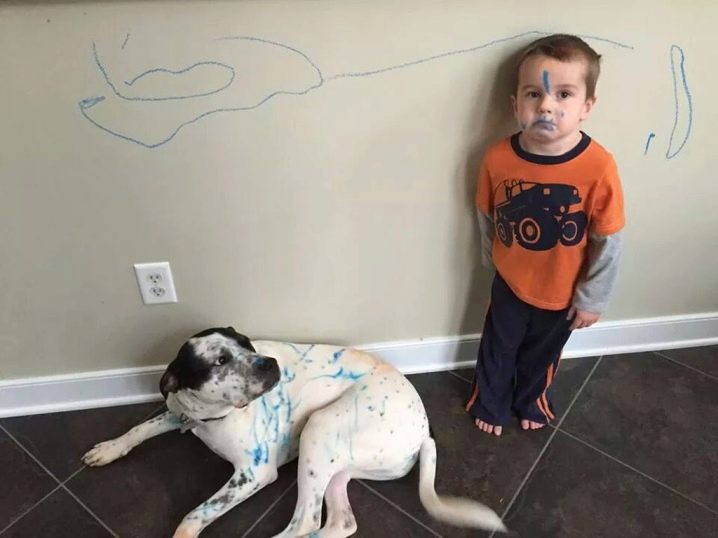
The psychological aspect is also important. Not every home has a living room, and according to the old tradition, we often gather at the kitchen table to discuss problems, drink tea with friends, and learn lessons while the hostess prepares dinner. So it should be cozy here. Wall coverings should not be psychologically crushing and annoying.
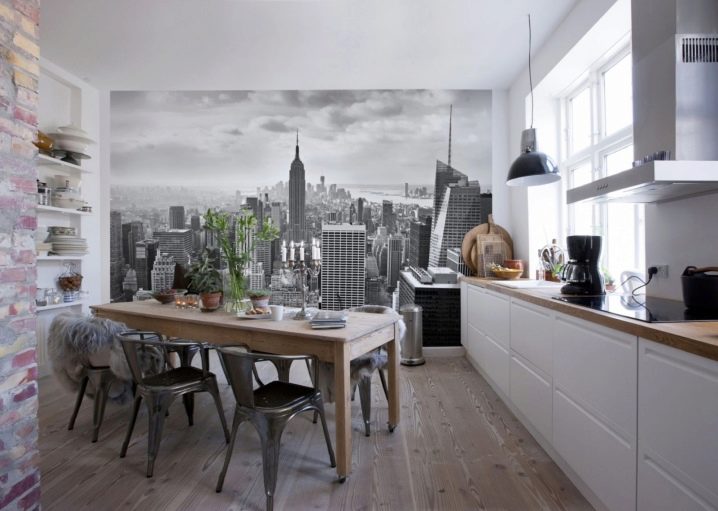
Where food is prepared, surprises are always possible: dripping fat, splashing water or juice, spilling wine. All of this should not damage the wall covering or should be easy to clean. Kitchen linens for walls simply have to be vapor permeable and resistant to sunlight.
When choosing, one should take into account such a factor as safety. Wallpaper glued over a gas stove without protection is the height of recklessness. Either you need to choose a fire-fighting material, or protect the flammable wall canvases with a screen, heat-resistant glass.
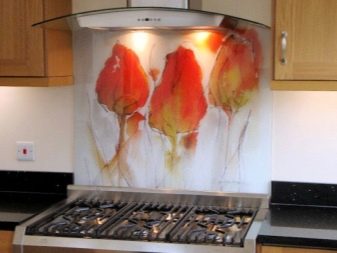
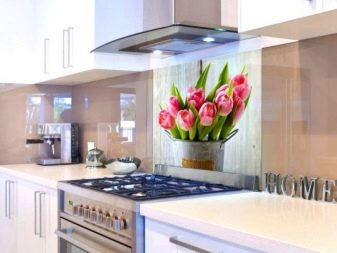
Economic feasibility also matters. If the renovation is supposed to be in a temporary dwelling, then there is no need to buy expensive wallpapers, even if they are very beautiful. And there is absolutely no need to take an unbearable loan for kitchen renovations just to show off in front of neighbors and relatives. It is better to choose inexpensive wallpapers, you will have the opportunity to replace them much earlier, which means that you will live in a new interior.
Consider the general style. Perhaps, when creating your kitchen space, you did not think about the style, its name and decor elements. But still, every home designer dreams of comfort, about whether the curtains fit the clothes for the walls, and the furniture matches the color of the kitchen corner.
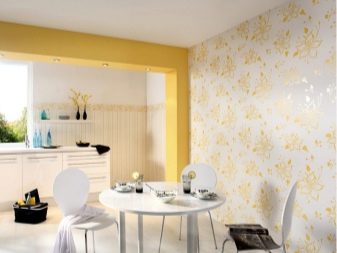
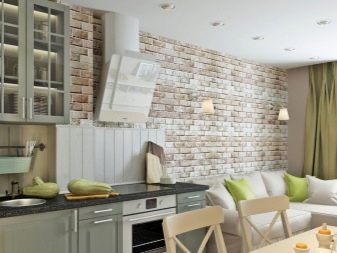
Another important point is the color scheme. This criterion is directly related to the psychological aspect.But with the right choice of wallpaper, you can also visually change the size of the kitchen both in breadth and upward.

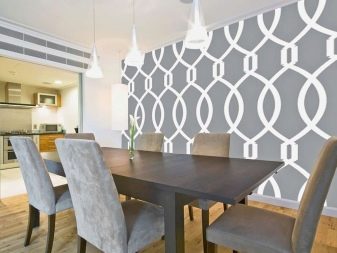
Think in advance about the convenience of gluing. Rolls are available with or without pattern joining. Of course, it is much easier to glue the pieces without joining. If the kitchen area is small, with a large number of wall-mounted items (cabinets, hoods, radiators, etc.), then it may turn out that more wallpaper is used for fitting than for gluing. In addition, the more corners, windows, doors, the more difficult it is to glue. This means that the material should not cause difficulties in gluing.
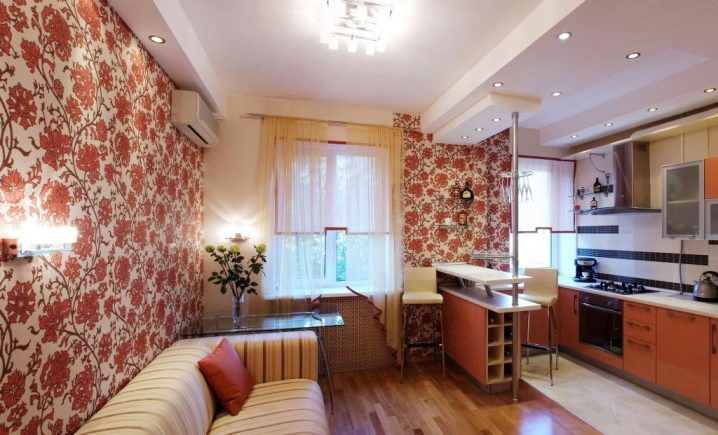
Please read the customer information on the label of each roll carefully before purchasing.
- On all pieces, the batch number must be the same, otherwise the shade of the wallpaper may be very different, and in dark storage rooms this may simply not be noticed.
- If the roll is 50 cm wide, then with a standard room height of 2.7 m, 3 full strips come out of one piece (standard roll footage is 10.5 m). Given the counter-fit, pattern repeat, it is always better to buy a small stock of 5-10% in case of incorrect calculation or local replacement of a fragment of the canvas.
- Whether to glue behind floor cabinets, refrigerators - depends on the desire and ability to move heavy objects. You need to be sure that if the gluing is not done there, then it will not be noticeable. But in any case, the roll should be brought behind the furniture as much as possible, at least 10-20 cm.
- It is important to choose and dilute the wallpaper glue correctly so that it lies well on the primer, does not turn out to be too thick or too liquid. The wall, which is pasted over with canvases for the first time, it is better to completely coat it with glue. If the room is humid, then it is better to use an anti-fungal composition. Each type of wallpaper has its own glue.
- By combining wallpaper, you can save money on the purchase: cheaper washable smooth pieces can be used instead of an apron or over the dining table, and, for example, more expensive liquid wallpaper can be used on the rest of the walls.

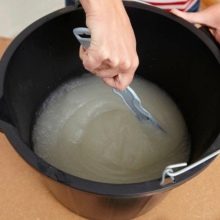
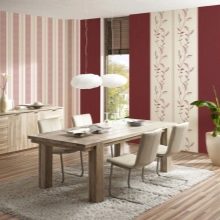
Each roll has an insert, which is marked:
- the sun sign speaks of lightfastness: from a half-sun to two suns (the higher the indicator, the less the wallpaper fade);
- wave - moisture resistance: varies from one wave to three with a brush sign (it is the brush that indicates that the wallpaper can be cleaned using water);
- multidirectional arrows will allow you to determine how to glue the wallpaper - with fitting or not, and how the pattern is displaced;
- the maklovitsy symbol will tell you how and where to apply the glue;
- a number of symbols will tell you how the canvases will be removed from the wall before the next repair.
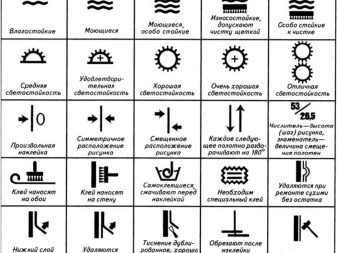
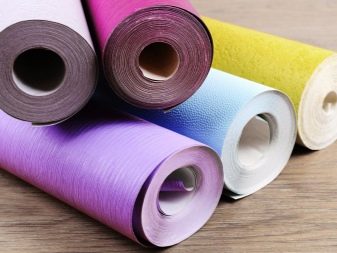
Views
Taking into account the above criteria, it would probably be wrong to say that some wallpaper is completely inappropriate. Yes, some types are more practical, others are easier to stick, and others are suitable for a living room connected to a kitchen. Therefore, we will tell you about almost all existing types and types of wall paintings, so that you can choose according to your pocket and desire.
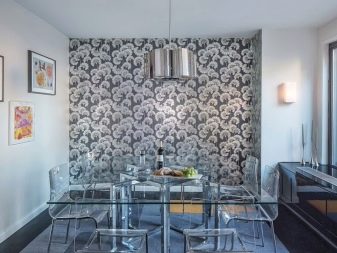
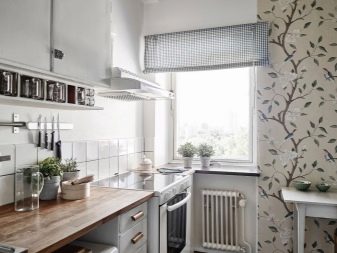
Paper
The simplicity of the paper layer is directly related to the low price of such wallpaper. Single-layer canvases need to be glued fast enough, because they instantly absorb the glue and begin to tear. Duplex (two-layer) wallpaper is thicker. Designed for the unassuming customer, they often feature floral designs favored by the older generation. An important positive point is the environmental friendliness of the material.
Modern wallpapers cannot be called boring: there are not only color drawings, but also plot pictures, geometry. If this does not seem enough, then you can use additional decorative elements: moldings, a combination of wallpaper, paintings. What you definitely don't need to do is cover the walls with paper canvases next to the sink and stove.

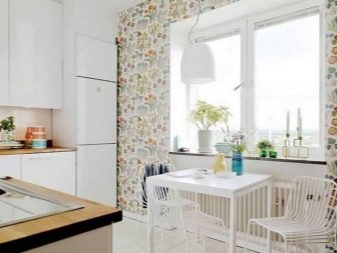
Non-woven
A polymer that resembles fiberglass and binds together cellulose and textile fibers, is the basis of a non-woven material called interlining. The undoubted advantage of the material is that it does not shrink after drying on the wall. It does not need to be lubricated, the glue is applied to the wall. When light hits the wallpaper, the material seems to glow from the inside, so the wall under it should be well primed. To create beautiful highlights, the top layer of the canvas is corrugated.
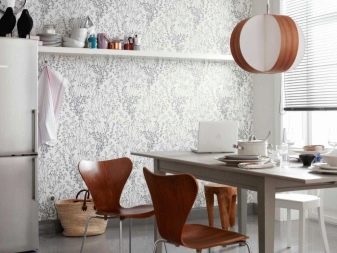
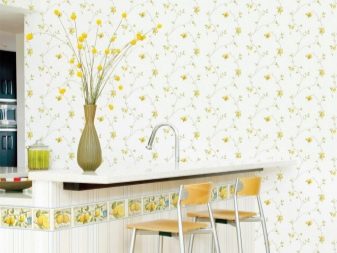
Non-woven pieces are much more durable than paper pieces. They hide well the defects of wall panels and are glued to almost all wall bases. The material breathes well and reacts to high humidity. And this affects the high price.
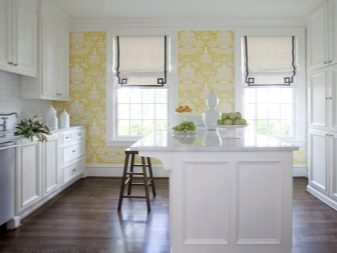
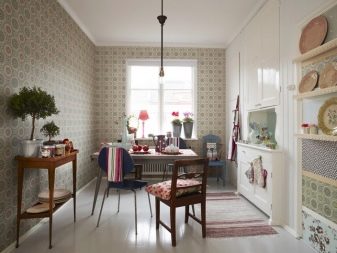
Non-woven material is often used for painting. Embossed or smooth pieces are glued to the wall, after which they are covered with acrylic paint. Wallpapers, which also need to be painted additionally, are popular because they hide wall defects well. And if there is a need to do this (hide cracks, irregularities), then use rolls for painting. Moreover, this can be done 5-6 times.
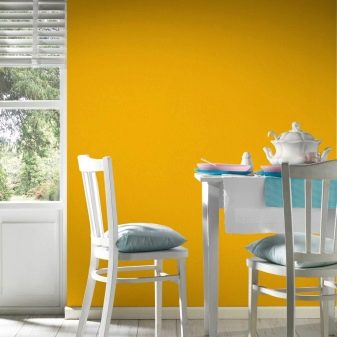
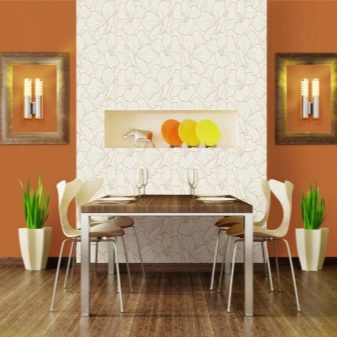
Non-woven is used to create exclusive designer wallpapers. For them, the highest quality material is used, individual drawings, at the request of the customer, you can metallize the canvases, use beads. Often photographs are used as a drawing. Therefore, it may be difficult to fit the pieces. Of course, designer wallpapers have a much higher price point.
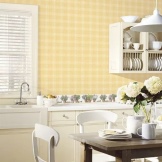
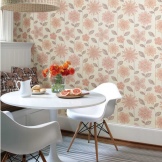
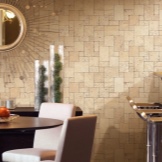
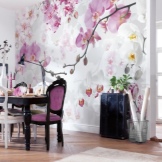
Vinyl
At the moment, the most popular are PVC (vinyl) wallpapers. And all because they have several varieties. In any case, the basis of the material is paper or non-woven. But a polyvinyl film is applied to the base in one of four ways. Therefore, the wallpaper is different in texture.
- Smooth or dense, resembling ceramic tiles or masonry (compact vinyl). Vinyl film, slightly embossed, allows you to clean the wallpaper even with a soft bristle or sponge. The surface of the wall under them should be relatively flat.
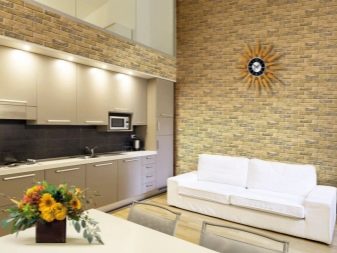

- Foamed canvases - the only breathable of all vinyl, but do not like water. Due to the volumetricity, they mask well the defects of wall surfaces. Usually, the foam from new rolls gradually crumbles, so it is not recommended to lean against such walls. Moreover, the wallpaper becomes "bald" very quickly in this place. Some of the foam canvases are paintable.
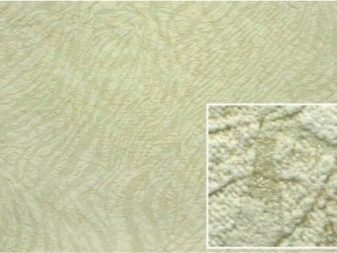
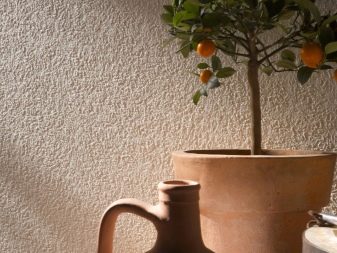
- Solid very high quality imitate natural finishing materials. Canvases with decorative stone, brick, textiles or textured plaster can be mistaken for a natural material from afar. And despite the fact that these drawings appeared a long time ago, manufacturers offer modern fashionable beautiful ideas.

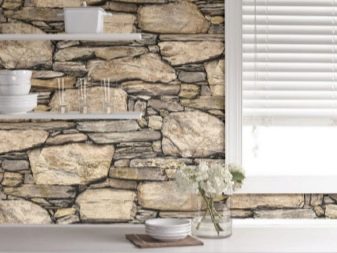
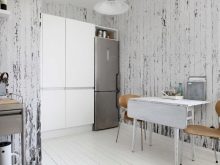
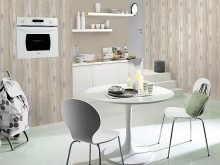
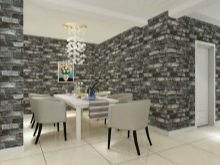
- Hot Stamping Cloths Called Silk Screen Printingare created with silk threads that give them a soft sheen. These rolls are much thinner, which means the wall must be very well aligned.
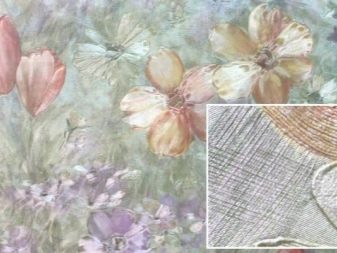
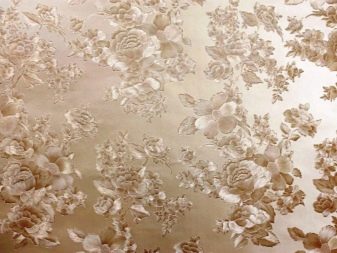
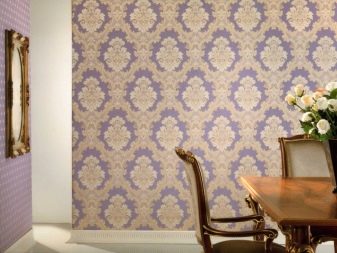
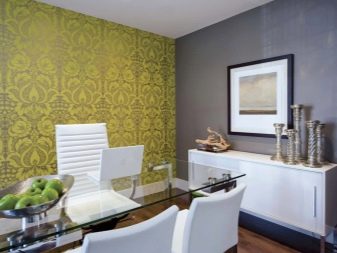
On average, vinyl canvases last 7-10 years. They are not afraid of ultraviolet rays. You need to glue them with great attention: when dry, the wallpaper shrinks, forming gaps between the canvases. To prevent this from happening, you do not need to wait too long for the swelling of the strip. Or you will have to put a narrow strip of wallpaper between the dispersed canvases, adjust the pattern. And to do this with foamed or embossed wallpaper is difficult.
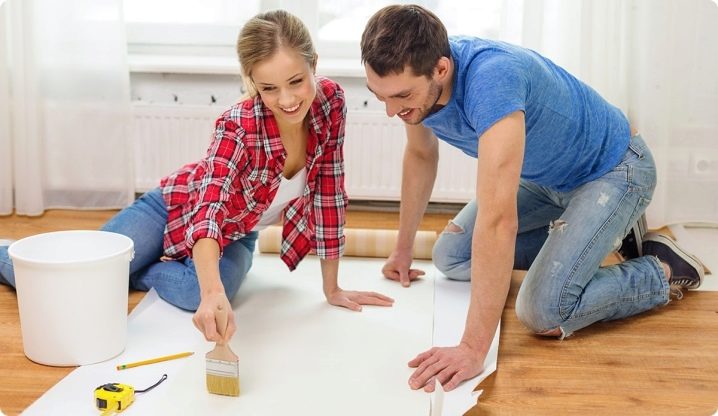
New rolls have a persistent odor, which should be removed before gluing, or more often ventilated after the wallpaper has dried. In a small kitchen it is difficult to imagine silk-screen printing (although it washes well), but in the dining room it will create an atmosphere of luxury and well-being. The rest of the types are quite acceptable for use in the kitchen. You just need to make sure that the walls are not affected by fungus.
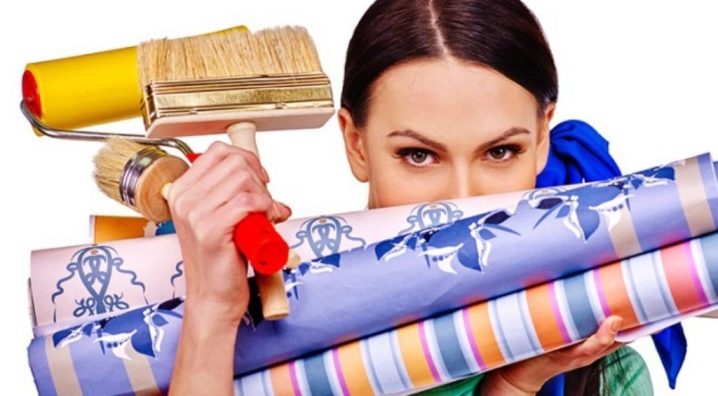
Acrylic
A kind of vinyl wallpaper is acrylic.Perhaps this is the easiest option. Their main advantages are lightness, low cost, and breathability. The main disadvantage is low wear resistance. But they can be used in the upper part of the room in combination with denser canvases or away from the kitchen set. And, of course, inexpensive material is suitable for a country house or temporary housing.
But there are several ways to produce acrylic wallpaper. And if acrylic foam is a cheap option, then not everyone can afford it on a non-woven basis or liquid.
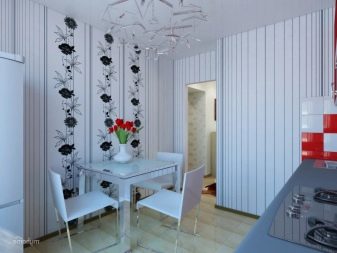
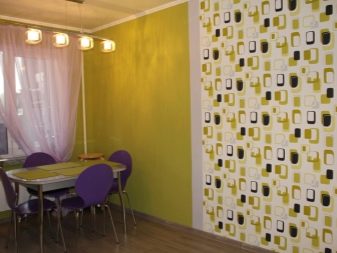
Glass fiber
Another modern type of paintable wallpaper is glass wallpaper. It may seem strange to some, but these embossed canvases are environmentally friendly, fireproof, moisture resistant, not afraid of fungus. They are difficult to tear or scratch, and they can last up to 15 years. They can withstand up to 10 paints, they are not afraid of accidental contact with acid. They are so durable that it can be difficult to clean the walls of them.
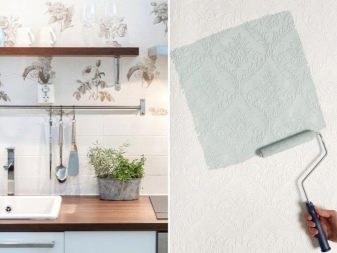
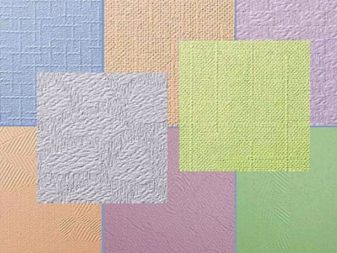
But this is also a plus: cobweb-type glass-fiber wallpaper or fiberglass will not only hide existing cracks on the wall surfaces, but also prevent the appearance of new ones. These types have a smooth surface. But dense canvases are sold with a textured pattern, due to which it is not at all necessary to paint the canvases in one color - creativity is welcomed. And even if you bought already painted canvases, nothing prevents you from repainting them to your taste.

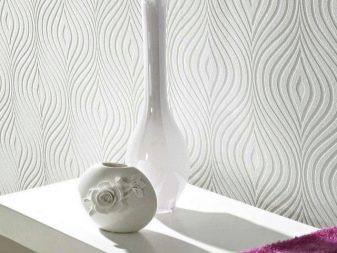
Liquid
If the kitchen has a large number of corners, arches, ledges and bay windows that are difficult to paste over due to the large number of small areas, choose liquid wallpaper. They have no seams, all flaws will be masked. If you haven't found the right shade, make the mixture yourself. Purchased mixes are not cheap. But in every house there are old newspapers, threads, New Year's rain, colored magazines and postcards. All this is suitable for creativity.
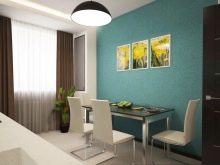
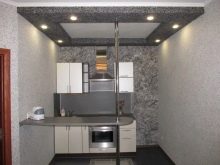
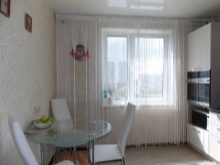
The process of making a mixture and gluing wallpaper, similar to decorative plaster, cannot be called simple. But if you have a desire to create, create designer exclusive walls in your kitchen in volume, color, then try using liquid wallpaper. And if, after drying, they are varnished, then neither water, nor steam, nor dirt can harm them. But if, nevertheless, this happened, then this type of wallpaper has an undeniable advantage: they do not need to be completely replaced, it is enough to re-glue a small piece of the damaged canvas.
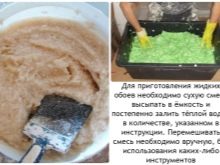

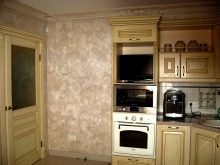
Natural
Natural wall coverings include non-woven or woven backing made of bamboo, cork chips, jute. Even the smell of these wallpapers creates a pleasant atmosphere. But again the problem: these materials also absorb odors. Therefore, they are suitable for large rooms with good ventilation over the stove. But bamboo repels water, like cork.
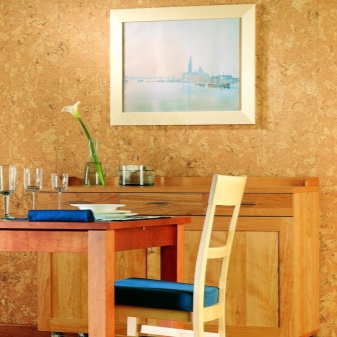
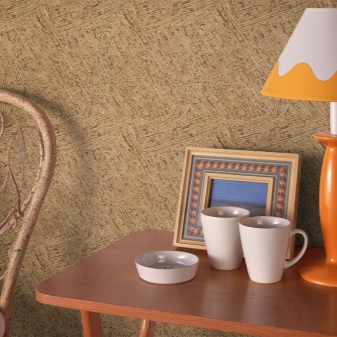
It is easy to hide construction errors under the wallpaper, the materials are resistant to abrasion. Looking at the walls made of natural material, the eyes, like the soul, will really rest in a cozy kitchen. Especially considering that manufacturers also offer denser cork flooring.
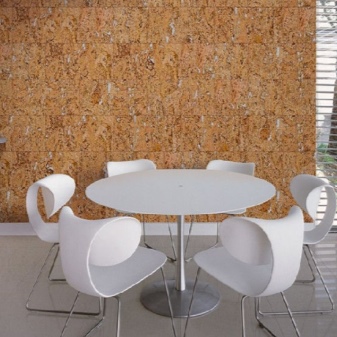
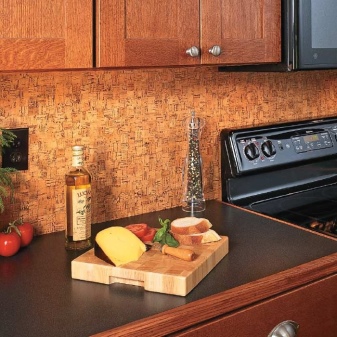
Tissue
It is irrational to use silk, viscose, linen or cotton on the walls in small kitchens. Of course, these are not fabrics in their pure form, but a woven material glued to a paper or non-woven base. But such canvases breathe very well, which means they absorb all the kitchen smells. Therefore, such wallpaper will be a real decoration for a dining room or a large kitchen-living room, but not for a "small size".
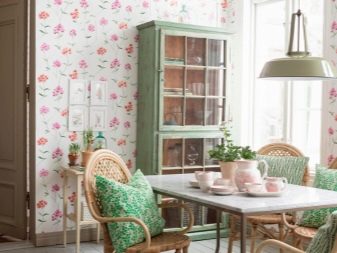
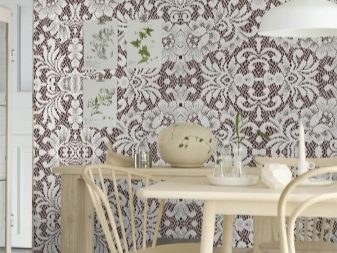
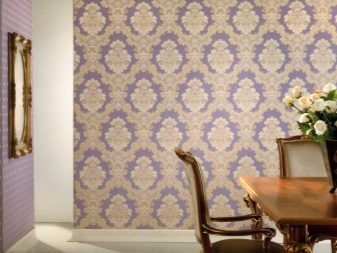
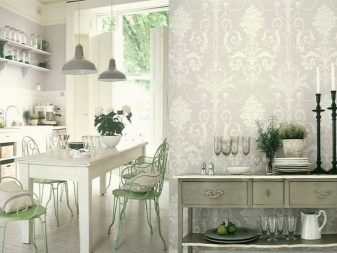
Laminated
The second type of textile wallpaper is laminated: textile threads are glued to the base, and the pattern is printed in rapport. This species is distinguished by a variety of colors and patterns, has anti-static and anti-mud impregnation. But like cloth, they don't like wet cleaning. Cloths can be vacuum cleaned and dry cleaned only.
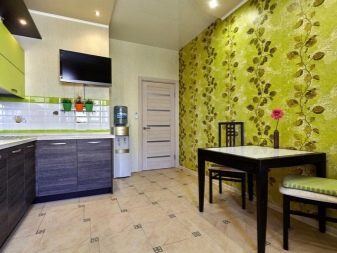

Quartz
An excellent option for pasting even on a slab is quartz wallpaper. Such a coating does not burn, does not wear out.Quartz sand, previously painted over and glued on a paper or non-woven base, is a hard material. It will be possible to wash it, but without a lot of water. Therefore, it is worthwhile to think carefully about whether it is necessary to paste over the walls where they will get very dirty. Perhaps, in this case, the combination option is better.
This material can be overpainted with latex paint. It does not tear when glued. It is difficult to scratch or cause a different look. No joints are visible between the stripes. And given the fact that quartz shines in the sun, the wallpaper will look very interesting in rooms of different sizes.
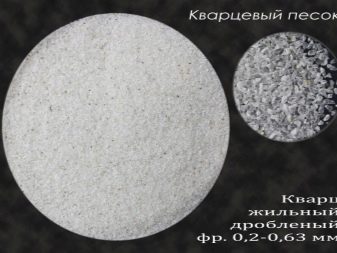
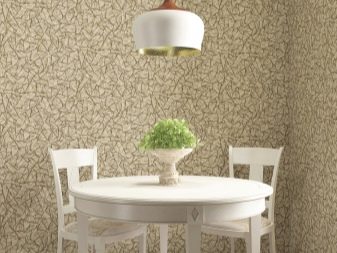
Metallized
It is just foil applied to a paper or fabric backing. But how beautiful metallic silver-plated, bronze or gilded wallpaper looks. It seems that there are mirrors with drawings on the walls. But the general mood of the kitchen will depend on the theme of the drawing: with the help of such wall coverings, you can make a living room in a classic style or a cozy kitchen with a bright sun on the wall.
This type of coverage will help to visually enlarge the room. But due to the fact that the canvases are covered with a thin layer of metal, they can dry only through the base. This means that they are suitable only for a wall that can absorb moisture. For example, for a wooden surface. Moreover, the wall should be perfectly smooth.
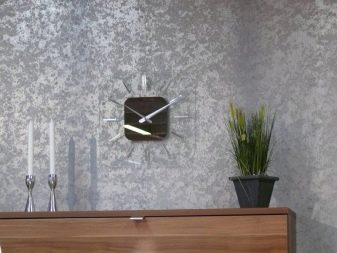

Linkrusta (linkrust)
This material is already 140 years old. It is also produced in rolls, but is very similar to stucco molding. The room must correspond to them, so the design of the kitchen must be well thought out. Wallpaper is expensive, but worth it: natural composition, breathability, excellent resistance to damage and water, can be washed with a damp sponge. The canvas can be painted, it is antistatic.
Every year, the coating is only fixed more firmly on the wall. This material is not for years, but for decades. Before gluing, the rolls are cut to the required size, rolled up again and completely immersed in hot water for 10 minutes. After removing the rolls from the water, they are unrolled and stacked on the floor, face up. The strips are left for 8-9 hours, during which the material will swell and will not shrink.
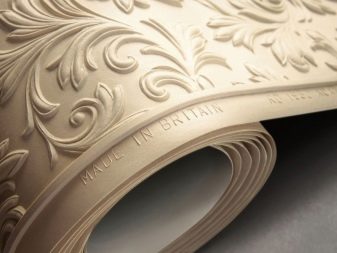
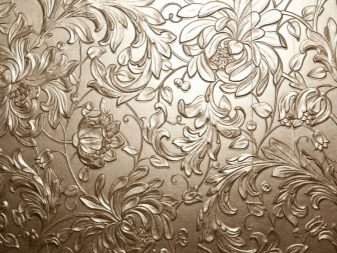
But fabric-backed linkruste does not need soaking. Before gluing, the glue is applied both to the wall and to the canvas. Not everyone will dare to spend a lot of money on them, not being sure of the result. But those who already have such wallpapers hardly regret it.

Wallpaper
Popular and loved again. Their variety is enormous. Perfect for any kitchen (especially non-woven or vinyl). You just need to choose the right drawing.
- For a small area, you should not take drawings with large objects.
- 3D printing will visually increase the space. Especially photographs with perspective or optical illusions.
- Dark kitchens - light photos.
- Drawings that are too bright quickly get boring.
- Photo wallpaper is used as a fragmentary gluing of one wall or part of it.
- When using photo wallpapers in the working area, they are covered with plexiglass or at least varnish.
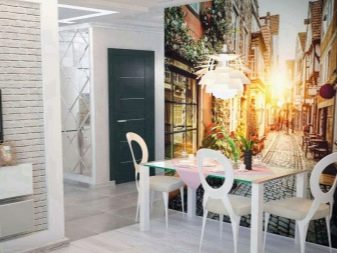

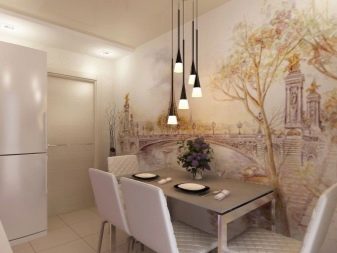
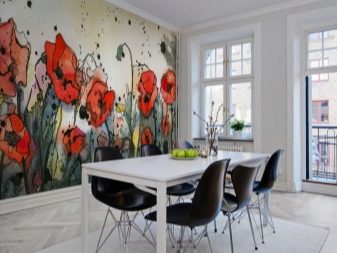
Self-adhesive film
"Self-adhesive" is a very handy thing for renovation work in the kitchen. No need to apply glue to the substrate or walls. It is already on the wallpaper and is hidden under protective glossy paper, on which the markings are applied. The vinyl version of the film in rolls is used as a means of protection against water, dirt and grease: as an economy option, many people paste over kitchen aprons with it and update furniture.
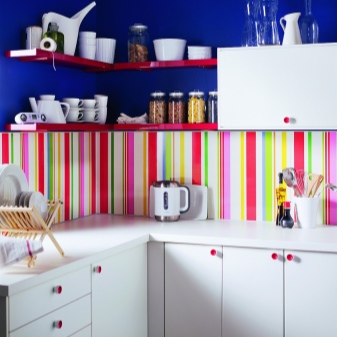

Another option is mosaic. The top layer can be very different, but the base is a self-adhesive film. Nice, simple, varied, fast. The main thing is to properly prepare the wall.
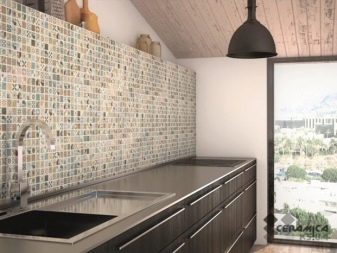
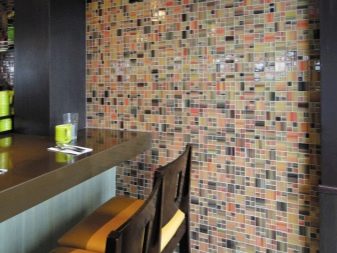
The third option is self-adhesive wallpaper. The material can be purchased in regular or custom designs.
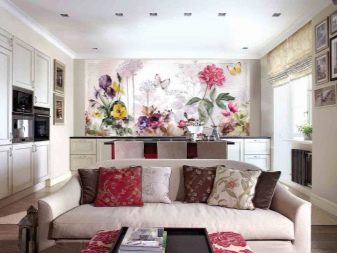
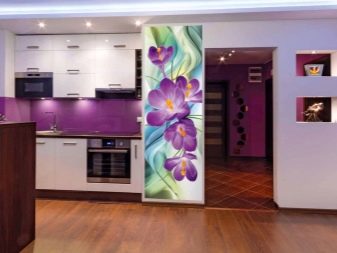
Since almost all of these options are smooth, careful alignment of the wall is required, otherwise all construction defects will shine through the thin film.
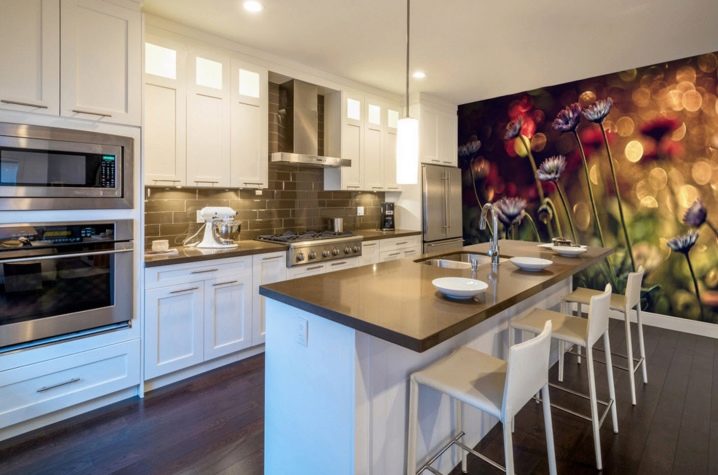
Washable
This is not a separate type of wallpaper, but their characteristic.But for a kitchen, especially a small one, this is one of the important indicators. It is indicated on the insert for each roll. The following types of wallpaper are washable:
- smooth and hard vinyl, silkscreen;
- non-woven fabric;
- glass wallpaper;
- liquid, varnished;
- cork and bamboo;
- metallized;
- photowall-paper covered with a protective layer;
- linkrust;
- self-adhesive film;
- quartz.
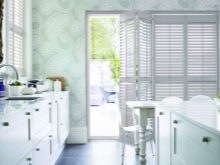

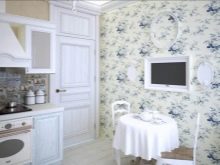
How to choose for the interior design?
For interior design use various techniques and rules:
- zoning of premises;
- functionality of the space;
- transformation of furniture;
- visual increase / decrease in space;
- one style solution;
- imitation of natural materials;
- combination of textures and colors;
- artificial aging of interior elements;
- dilution of laconicism with decorativeness;
- balancing bright elements;
- leveling the concept of "fashionable" with the concept of "stylish".
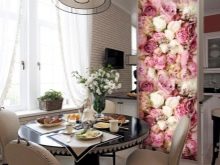
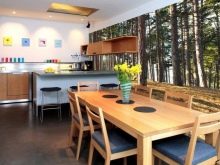
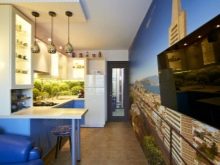
All this also applies to the arrangement of the kitchen. And wallpaper plays a very important role in this.
Zoning
Kitchen zoning is easy to accomplish through the use of wall paintings of different colors, textures, types. In this case, you can use different options for combining wallpaper:
- one color, but different shades;
- one color but different patterns;
- contrasting colors;
- monochrome one wall, the rest with a pattern (or vice versa);
- a kitchen apron is a bright spot, the rest of the walls are pastel shades;
- separation of the dining area from the working area with photo wallpaper for a fresco, brick or wood.
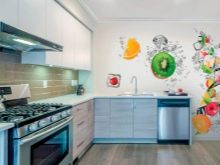
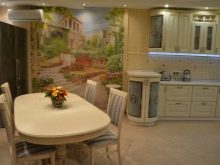
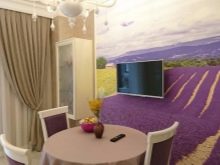
Combination
The combination can also be vertical: the lower part of the kitchen is of darker non-marking colors, the upper one is lighter. Usually, special wallpaper borders are used as a dividing strip, but liquid wallpaper, self-adhesive film and other types of finishes are also suitable. But it is still not worth getting carried away with the curbs, so that the room does not seem cut.
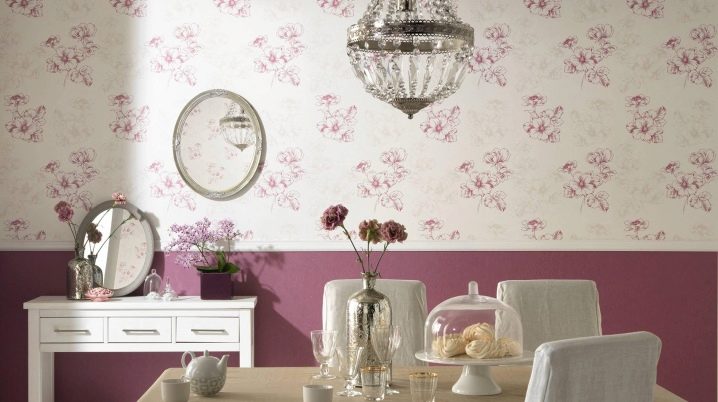
The classic combination is black and white. This combination will create a noble picture, but in its pure form the white color is quite easily soiled, therefore they use a black and white drawing, speck, canvas "marbled".
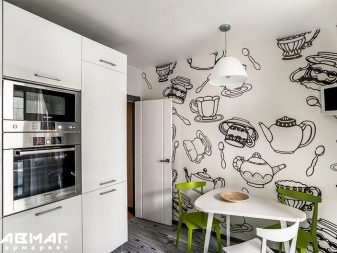
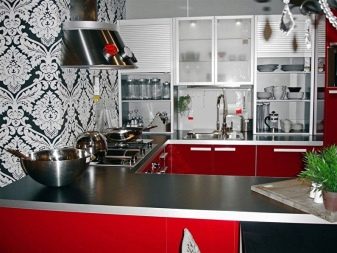
If you don't know which colors to combine, but you want to use several colors, rely on contrast.
Visualization
With the right selection of canvases, you can create a visual picture when a 6-meter kitchen really seems larger. This is achieved in the following way.
- Cover wallpaper for painting with one or more pastel shades. Or choose a light wallpaper in a small drawing.
- A vertical pattern (not necessarily a strip) will raise the ceiling. The same applies to the combination of canvases: for example, the arrangement of vertical wallpaper only above the table.
- As a piece of decoration, you can use several strips of metallized wallpaper or self-adhesive film or other mirrored sheets. But only a few stripes! The kitchen should not scare you with its own reflections.
- Wall murals depicting windows, streets receding into the distance, the sea, etc. will also help expand the space. But in this case, the photo is a bright spot, the rest of the walls should be muted shades.
- Too high ceilings in a small kitchenette make it look like a box. Pasting the ceiling and the upper part of the walls with one type of wallpaper (without stripes and patterns) will help to correct the situation, and the rest of the walls (for example, at a standard height of 2.7 m) with another brighter color. Separate different types with a border.
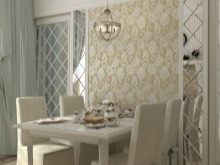
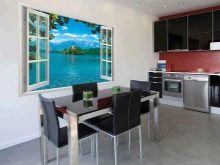
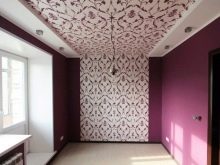
Style
For a long time, designers said that a room should be decorated in the same style. As a result, 9-meter kitchens in classic or modern style appeared in Soviet Khrushchev buildings. Everything is good in moderation: if you managed to pick up interior items in the style of minimalism, that's great. No - do not be discouraged, the concept of "just beautiful" has not yet been canceled. Or a mixture of styles - eclecticism - can help out.
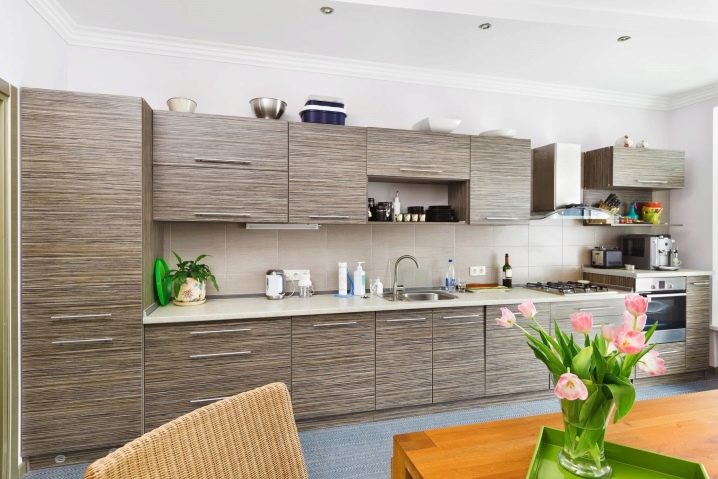
But if you still want to match a specific style, consider their main aspects.
- Provence: tenderness, simplicity, lavender flowers and pale pink, turquoise and soft greens; a lot of white or artificially aged wood. The first associations with style are village, peace, comfort.
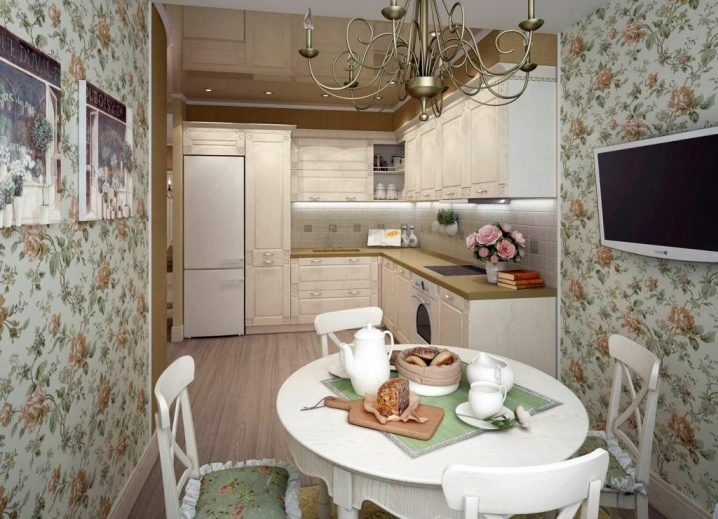
- Modern is associated with modern style, but in reality he is much more multifaceted: he loves gray and metallic, he can use a few bright spots or a completely white interior. Furniture plays an important role.
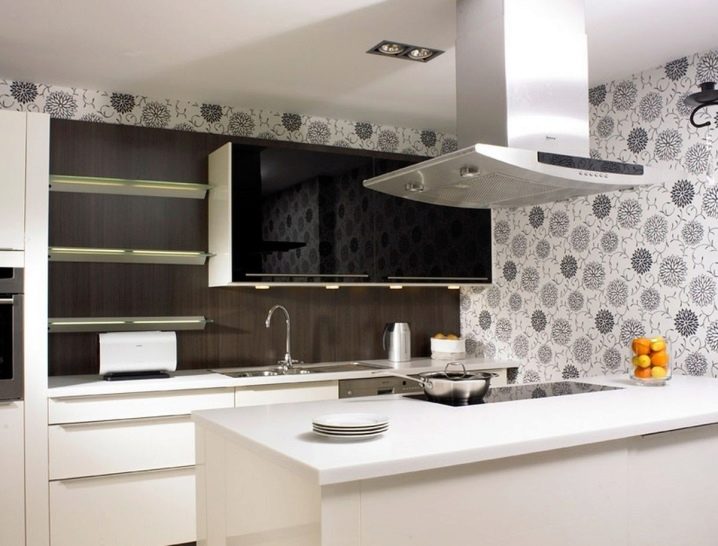
- A classic kitchen needs space. Wallpaper - silkscreen or linkrust, metallized or embossed glass wallpaper. The main thing is not to overdo it with colors and general decor, so as not to get bad taste.
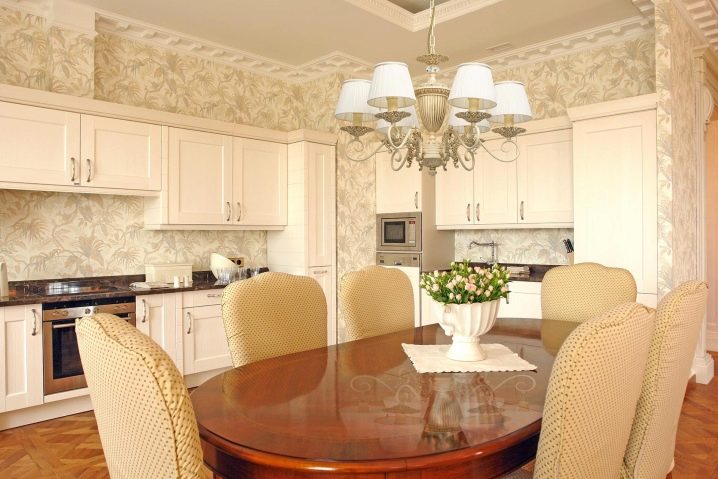
- Scandinavian cuisine Is northern restraint and 50 shades of white. Wallpaper can be white or in a small discreet flower on a white background. The second option is an imitation of natural materials: bleached wood, brick. Decor elements will play an important role: skin on the seats or floor, homespun rug.
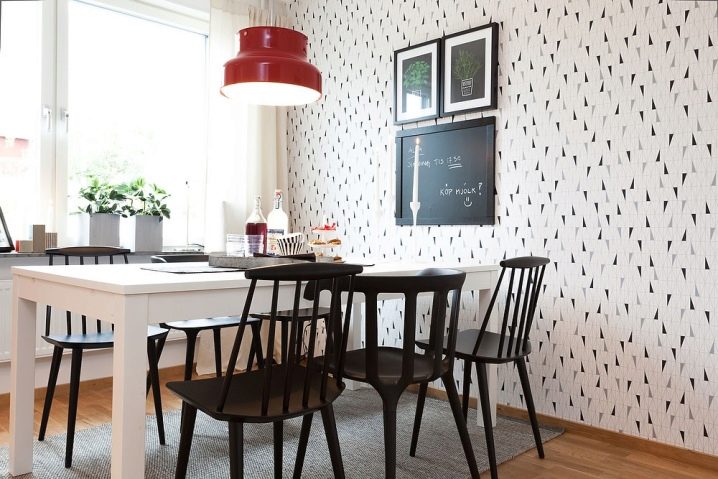
- High-tech it is important to maintain the color scheme and choose the right furniture. For walls, white or very pale shades of pastel colors, gray, sometimes black colors are used. No flowers, but there may be a blurry abstraction, very rarely - a black and white photo. Sometimes the walls are finished with wood or brick. Hi-tech is chrome furniture, laconic finishes and high functionality.
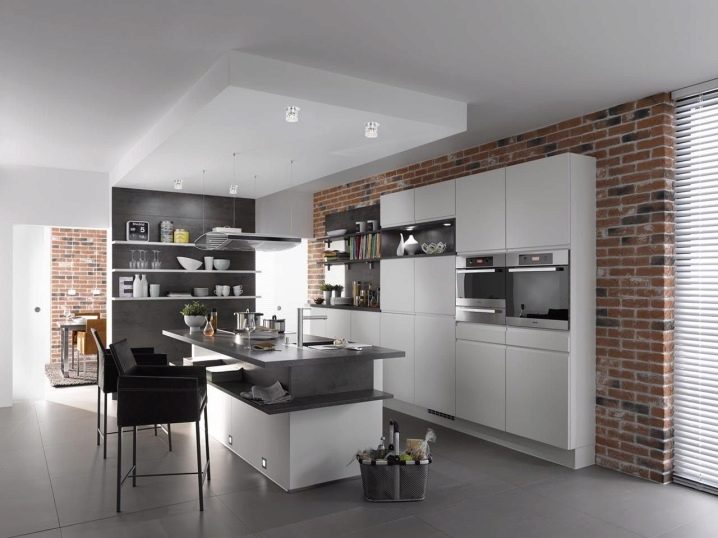
Colour
The psychological component of the project plays an important role in the design. There are at least two aspects to making a kitchen cozy: correct color matching and correct arrangement of objects.
- Shades of yellow awaken the appetite. The eater is cozy, comfortable, and his hand reaches for the plate. But you need to be careful with fluorescent colors: lemon, poisonous yellow - they irritate the eyes.
- Be wary of designer suggestions for a black and red kitchen: for a small room, this is not at all a suitable color, and in a large room it can only be compensated for by bright sunlight. The red color not only makes you act actively, keeps you in good shape, but also causes irritation.
- Blue-blue scale reduces appetite, soothes. And the marine theme is a real relaxation after a hard day's work. But these colors are cold. In the fierce winter, going into the blue kitchen can be uncomfortable.
- Green has always been the color of tranquility. It is important to choose the right shade and avoid poisonous patterns. It goes well with yellow, orange.
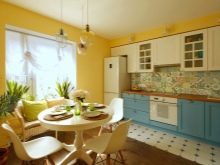
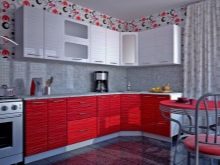
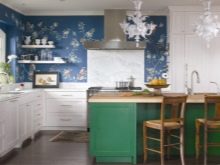
To say that one color is suitable for the kitchen, and another cannot be categorically used, cannot be. Everything is good in moderation.
Feng Shui
This is also confirmed by the Taoist practice of mastering the space of feng shui:
- using bright colors in furniture, balance them with light wallpaper;
- do not make a dark ceiling or the upper part of the walls - dark colors cause anxiety and a feeling of tension;
- according to the doctrine, the use of small mirror surfaces such as mosaics is not recommended, because reflection is broken in small tiles, which means life is broken;
- the kitchen must reflect all vital components: fire, water, earth, air; if some of this is missing, you can pick up wallpapers or photo wallpapers with these images;
- in order for the body to tune in to losing weight, there should not be images of food on wallpaper, frescoes, calendars, paintings; flowers, landscapes are more suitable for the mood.
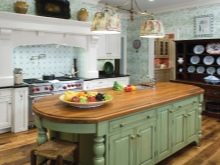
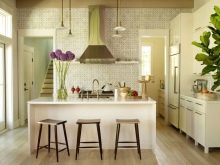
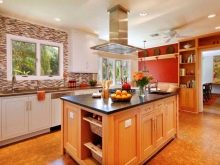
When ideas for renovation are discussed, you always want the kitchen to be modern and fashionable. Hit should fit into the general style of the apartment or house. Or you will have to come up with some kind of move explaining why the design of the kitchen and the adjacent corridor is diametrically different. Especially if the passage to the corridor is open arched. Sometimes, to be a home designer, you don't have to change yourself: the main thing is to be comfortable.
Original ideas and combinations
However, it is important to be able to use interesting experiences and ideas to create a beautiful kitchen.
For example, this is how the idea of zoning a large kitchen - living room might look like.Two types of wall coverings: brick or bleached brick wallpaper and designer wallpaper. If more colors were used in the wallpaper, it would be overkill. Here, the kitchen is designed in very laconic colors and very competent red accents: dishes, a kettle, girls' lips on the wallpaper.
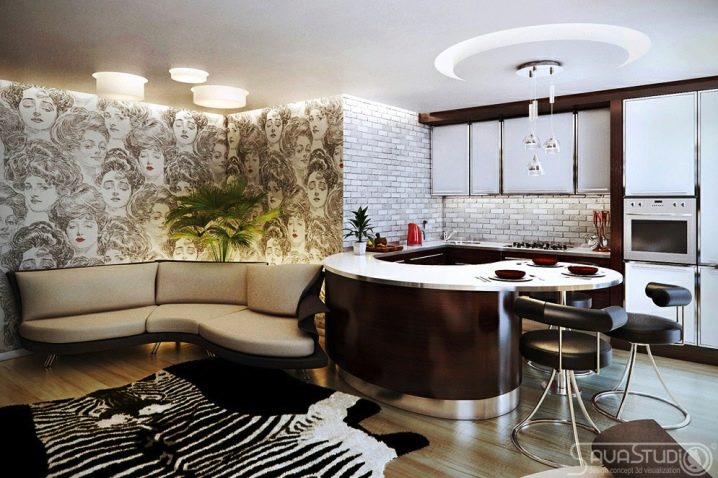
Photo wallpaper with 3D effect gives many possibilities for completely different kitchens. Not every home craftsman will be able to install a plexiglass apron over the wallpaper, but this is the case when you need to invite a professional to get such beauty. In addition, well-organized lighting is important for any wallpaper. This kitchen is a prime example of this.

The hit of the outgoing year is a riot of colors in volumetric photo printing. To appreciate this original idea, you need to balance it with plain furniture. This should be the only bright spot in the kitchen.

If there are people who like to paint on the walls in the house, these self-adhesive chalk or marker wallpaper / film are for them. You can draw on them with chalk or liquid chalk markers. It is a pity that while the variety of wallpaper colors is limited.
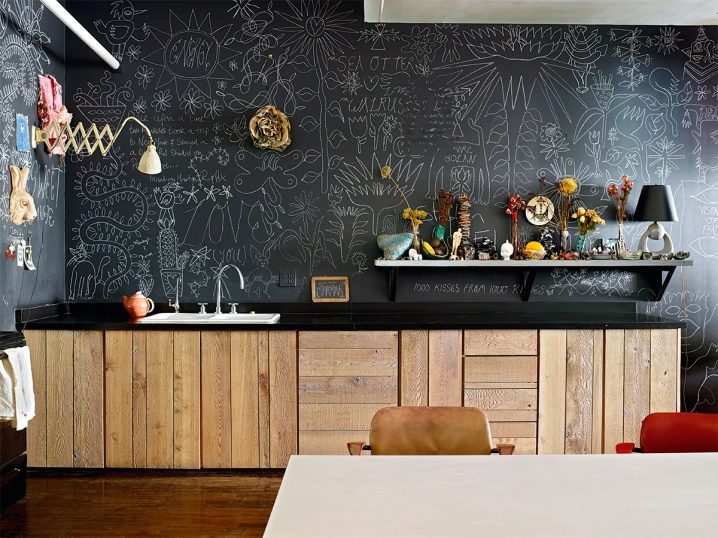
What you see in this photo is not typical of the classic style. But a modern kitchen in a classic style looks exactly like that. And this is great: there is beauty, but no pomp; there is functionality and grace. Well-organized space, plenty of work space.
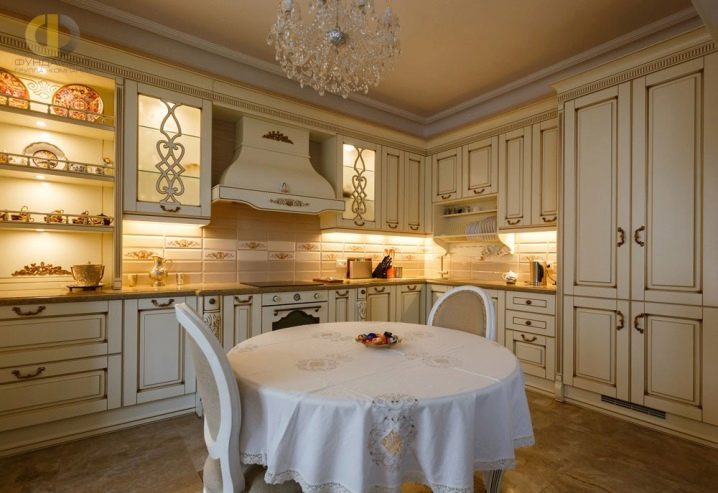
This is the case when modern does not mean “golden and shiny”. A small retro kitchen was able to absorb the spirit of our parents' youth, convenience and functionality. If both walls were in gray-blue tones, then the room would be dark. But the combination of different colors, as well as different wall covering materials, made the kitchen lighter and more comfortable.
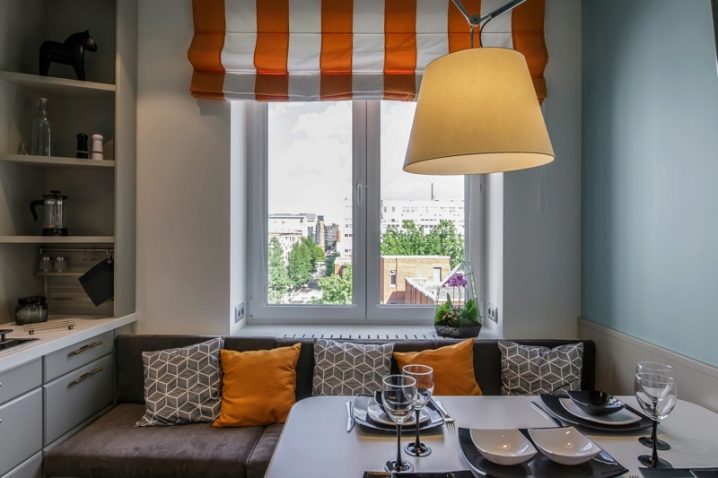
But what professional designers warn about is the excess of everything. Yes, indeed, the trend this year is the combination of gold and burgundy. But, perhaps, there are too many shades, lighting fixtures, pretentiousness, but little space. Perhaps it would look better in a large square dining room.

There seems to be nothing out of the ordinary in this photo. But one glance is enough to understand that harmony reigns here. This is what a modern feng shui kitchen might look like. Discreet but attractive wallpaper, a lot of light, the presence of all four elements. Simplicity, comfort, tranquility.
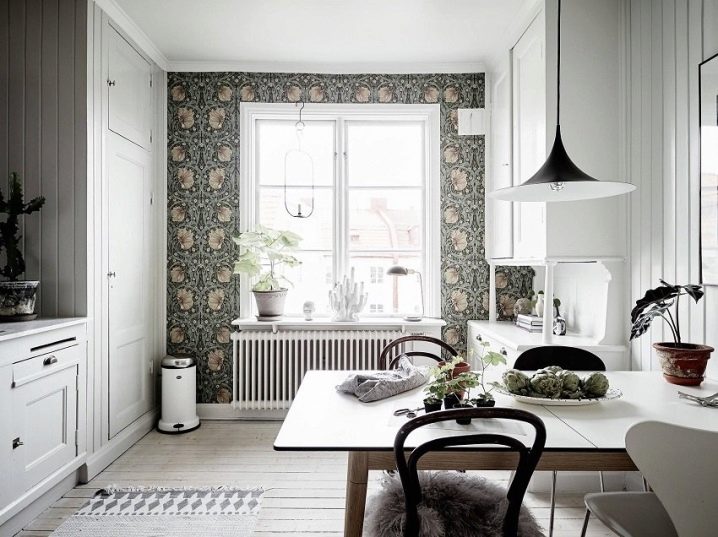
How to choose wallpaper for the kitchen, see the video below.













The comment was sent successfully.